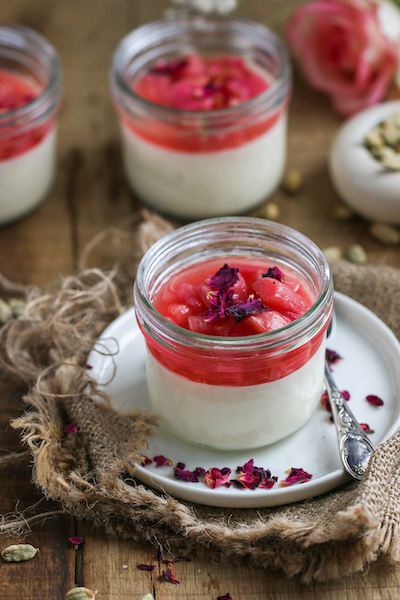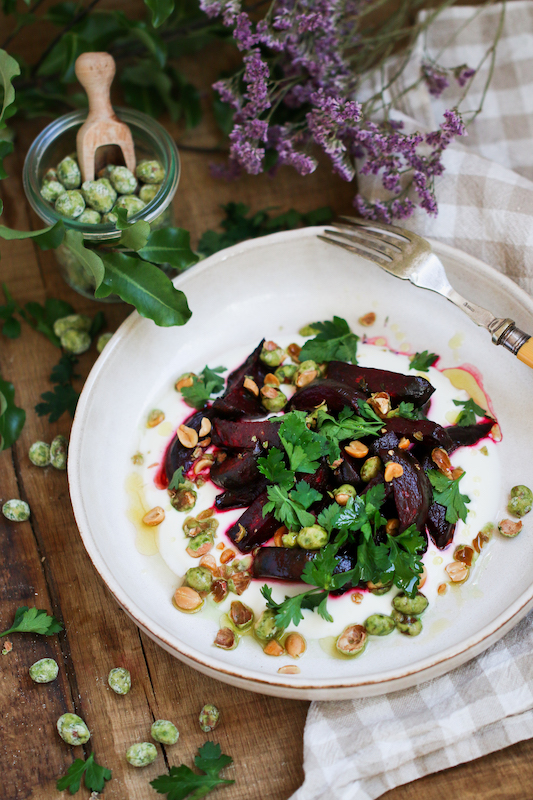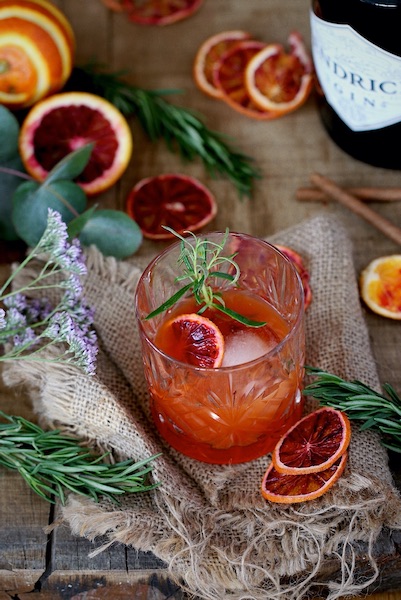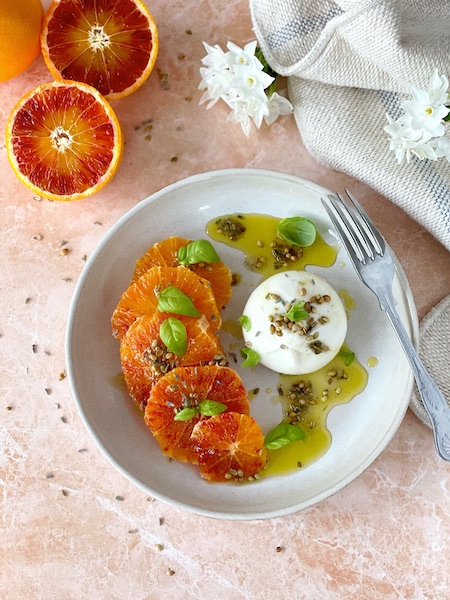
Overall, Panna Cotta must be one of the best desserts to experiment with! It is a very easy dish to prepare (although it doesn’t look it) and you can make it ahead of time, which is fantastic when you have guests to deal with. It also has a great shelf life – some sources mentioned 10 days, although that sounds a bit optimistic! 😉 It is just so versatile! Once you have found a good base recipe, you can customise it to your taste, either by adding: fruits (passion fruit, strawberry…), flowers (rose, lavender, chamomile…), herbs (basil, rosemary…) or spices (cardamom, cinnamon, star anis…); steep the cream with tea bags (matcha, earl grey…) or exchange the milk with yoghurt, buttermilk or even soft goat cheese – the possibilities are endless!!!

My newest creation is a romantic dream of a panna cotta, with a floral accent suffusing the cooked cream, tinged with the beautiful rose colour of the Drunken Rhubarb – perfect for a date night but don’t exclude it for dinner parties!!! It does truly have the wow effect! I’ve exchanged the milk for buttermilk which creates such a wonderful creaminess in spite of the fact that buttermilk contains fewer calories and less fat than milk – read why further down! The cream is infused with cardamom pods and rose water. The rhubarb is poached in a vanilla sparkling wine syrup. It’s just a gorgeous flavour combination!
Tips / Variations:
- Leave out the cardamom.
- See what quantity of rose water you want to add as the intensity varies depending on the brand you are using.
- Exchange the buttermilk with greek yoghurt or milk. This will change the consistency and taste of the panna cotta but will still taste amazing!
- Use strawberries instead of rhubarb.

Buttermilk in Baking/Cooking
Traditional buttermilk is the byproduct of churning cream into butter. Though the buttermilk you buy today is usually cultured (beneficial bacterias have been added to it), as well as being pasteurised and homogenised. In Indian culture it is often drunk after a meal as it helps to wash down the spicy and oily food and soothes the lining of the stomach. It also cools down the body temperature, great when experiencing hot flushes.
The lactic-acid-producing bacteria (cultured) that is added to the buttermilk increases the acidity, thereby preventing unwanted bacterial growth and increasing the product’s shelf life. The bacteria also ferments lactose which results in its slightly sour taste. The beautiful thing about this increased acidity is seen when used in cooking:
- In combination with baking powder or bicarbonate of soda, it will create tiny bubbles which will make the texture of your breads, cakes, biscuits and pancakes fluffier and lighter.
- Marinading meat such as chicken or pork in buttermilk will help to tenderise it.
- The lactic acid in the buttermilk decreases the ph, thereby causing it to curdle. Therefore the texture of a buttermilk panna cotta will be creamier and thicker than when using milk.
Mores Desserts Please!
- Basil Pannacotta & Strawberries in Prosecco Syrup
- Champagne Truffles
- Christmassy Tiramisu – also works outside of the Christmas time! 😉

Rose Buttermilk Panna Cotta & Drunken Rhubarb
A Romantic Dream of a Dessert – perfect to impress at a Date Night or a Dinner Party.
Ingredients
- 125ml (1/2 cup) double cream
- 2 tbsp caster sugar
- 3 cardamom pods – lightly crushed
- 1 gelatine leaf
- 125ml (1/2 cup) buttermilk
- 1/4 – 1/2 tsp rose water – do taste as some rose waters are more potent than others
- 100ml (3.4 fl oz) Prosecco or Champagne – if you’re feeling decadent 😉
- 40g (<3 tbsp) caster sugar
- 125g (1 1/4 cups) rhubarb – cut in 1-2 cm pieces
- 1/4 vanilla pod
- edible rose petals
Drunken Rhubarb:
Decoration (optional):
Directions
- Start with the panna cotta. Add the cream, sugar and cardamom pods to a saucepan. Heat on medium heat until almost simmering – you’ll note the steam. Set aside.
- In the meantime, soak the gelatine leaf in a bowl of cold water for 5min. As soon as it’s done, take the gelatine, squeeze out any excess water, add to the saucepan with the cream, stir until dissolved – this can happen before the cream is ready.
- Add the buttermilk and the rose water to the cream and let it rest for 15-30min.
- Strain the cream through a sieve into a small jug, then from a jug into 2 glasses (this will make it easier to keep the glasses clean). Place into the fridge for at least 3 hours or overnight.
- While the panna cotta is resting, start with the ‘Drunken Rhubarb’. Add the Prosecco or Champagne and sugar to a saucepan. Heat on medium heat until the sugar has dissolved.
- Scrap the seeds of the vanilla pod, add to the pan along with the pod.
- Add the rhubarb pieces bring to a light simmer and cook for 5min until soft but not falling apart – it goes really quick!
- Take off the heat and let cool down. Pour into a bowl or an airtight container, keep in the fridge.
- When you are ready to serve, take your panna cotta and rhubarb out of the fridge. Spoon the ‘Drunken Rhubarb’ and its syrup onto the panna cottas. Sprinkle with edible rose petals if available.
- Enjoy!
For more Françoise La Prune, follow me on Facebook, Instagram, Twitter, Tumblr, Pinterest, Bloglovin’ or subscribe to receive the newest posts via email.







Leave a comment